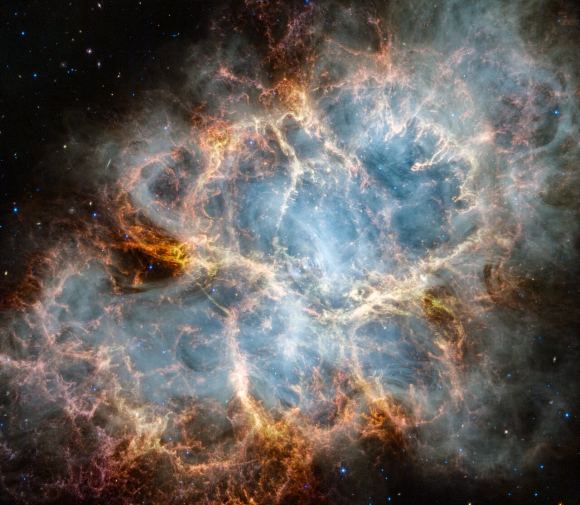Everybody knows that the explosive deaths of supermassive stars (called supernovae) lead to the creation of black holes or neutron stars, right? At least, that's the evolutionary path that astronomers suggest happens. And, these compact objects exist throughout the Universe. But, no one's ever seen the actual birth process of a neutron star or black hole in action before.
That changed when supernova SN 2022jli occurred in the nearby galaxy NGC 157. This catastrophic stardeath event was discovered in May 2022 by amateur astronomer Berto Monard. Its behavior quickly caught the attention of two teams of professional astronomers. Observations from the European Southern Observatory's Very Large Telescope and New Technology Telescope provided high-quality light-curve measurements as well as other data. Those measurements and radiation showed something unusual, not like a "normal" supernova.
Focusing on the Supernova
Astronomers Ping Chan of the Weizmann Institute of Science in Israel and Thomas Moore of Queen's University, Belfast, Northern Ireland each led teams who studied the weird behavior of this supernova. Their analysis showed the supernova explosion ended up creating a massive compact object. That was pretty exciting because until now, no one has observed the process happen in (almost) real-time. That makes the light curve a useful window on the creation of either a neutron star or a black hole.
Chan's team wanted to establish a direct connection between the death of a massive supergiant star and the creation of the object. "In our work, we establish such a direct link," Chan said and reported the work at the recent American Astronomical Society meeting.
Moore's team was also intrigued by the light curve of this event. "In SN 2022jli's data we see a repeating sequence of brightening and fading," he said. "This is the first time that repeated periodic oscillations, over many cycles, have been detected in a supernova light curve."
Finding the Missing Link Between Supernovae, Black Holes, and Neutron Stars
Supernovae occur pretty frequently in the Universe. Astronomers study them and chart how their brightness changes over time. After the initial explosion, the light it generates fades out over some time. Usually, it's a pretty smooth change in the light curve. But, SN 2022jli didn't fit the "normal" curve, so to speak. Instead of fading out smoothly, the brightness of light from the explosion oscillated in a 12-day-long period. Both teams noticed this oscillation, and Chan's group also detected the motions of hydrogen gas and gamma-ray bursts in the region.
What story does SN 2022jli's strange light curve tell us about the creation of black holes or neutron stars? Let's start with the explosion itself. It was a fine example of what astronomers call "Type II supernovae". Basically, at the end of its life, a supermassive star collapses and then explodes outward. The remaining core collapses further to create one of two types of massive objects. A neutron star is one. It's what's left over after the rapidly collapsing core of the star crushes the remaining protons and neutrons of matter into neutrons. It's essentially a ball of neutrons. Most neutron stars have about the mass of the Sun crushed inside themselves. But, they are small—really small, compared to their progenitor stars. Most are maybe 20 or so kilometers across.
Stellar-mass black holes also come from the deaths of supermassive stars that were at least 20 times the mass of the Sun or more. The core collapses during the event, the same as with a neutron star. But, the mass is so great that the event creates a black hole, crushing all the leftover core material into a pinpoint of dense matter.
Putting Together the Link Between Supernovae and Compact Massive Objects
All the data from the observations helped both teams suggest the following scenario. Like many massive stars, the progenitor of SN 2022jli appears to have had at least one companion star. It probably survived the supernova explosion. The outburst threw out huge amounts of material, and the companion star interacted with it. That caused its atmosphere to "puff up". The newly created compact object passes through the orbit of the star and sucks hydrogen gas away from the star. That material funnels into an accretion disk around the compact object. Those periodic episodes of matter theft from the star release lots of energy, which gets picked up as regular changes of brightness in the light curve measurements as well as the gamma-ray signals.
Of course, we can't see light coming from the compact object itself—whether it's a neutron star or a black hole. But, we do see radiation from the heated material drawn into the accretion disk around the compact object. And, since astronomers were able to track the changes in the light curve due to activity by the massive object, it amounted to watching its formation. "Our research is like solving a puzzle by gathering all possible evidence," Chen said about the findings. "All these pieces lining up lead to the truth."
The next step is to figure out exactly what astronomers saw being formed. Was it a neutron star with tremendously strong magnetic fields and gravity, or a black hole with gravity so strong nothing (not even light) could escape it? Determining that requires additional observations and the capabilities of telescopes not yet online, such as the Extremely Large Telescope due to begin operations in a few years.
For More Information
Missing Link Found: Supernovae Give Rise to Black Holes or Neutron Stars
SN 2022jli: A Type 1c Supernova with Periodic Modulation of Its Light Curve and an Unusually Long Rise A 12.4-day Periodicity in a Close Binary System After a Supernova
 Universe Today
Universe Today


